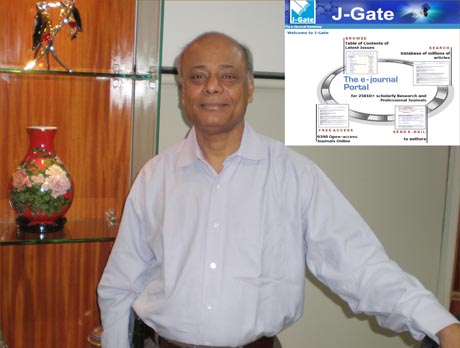
J-Gate the flagship database of Informatics India, the Bangalore-headquartered Indian pioneer in electronic information products and services, has reached a significant global landmark , covering over 25,000 journals and indexing 1.7 million articles every year from these journals, making this arguably, the world’s the largest data base of English language periodicals.
Launched in 2001, J-Gate is a global e-journal gateway, which provides seamless access to millions of journal articles and is an abstracting and indexing portal for online journals published across the world. This is a multi disciplinary product, enabling a user to search by author, title, keyword etc. This was the first instance of such a product covering all disciplines of knowledge being brought out in the online world.
The effort initially covered some 2,000 journals from publishers with simple search features. With each passing year its coverage of number of journals and search features improved -- and today it has crossed 25,000 journals from 8,348 publishers. Just as a comparison, the British Library’s Inside Information Plus, indexed articles from 21,000 journals, but suspended its service in 2007.
While a few similar services EBSCO host, ResearchGate, Serial solutions, Ingenta are being brought out, J-Gate along with its customized content services (JCC and JCCC) and specialized features seems to be ahead with metadata and links to Full Text for 22 million articles.
Says N.V. Sathyanarayana, founder, Chairman and Managing Director of Informatics: “ We are proud and humbled that J-Gate is used the world over by millions in academic, corporate and research organizations. In India, it is accessed by nearly a million users through 150 Universities, several medical and engineering colleges, management schools, and research since 2005”.
He adds: "When we conceived J-Gate twelve years ago, we wanted it to be the world’s largest e-Journal portal and an affordable multidisciplinary bibliographic database. We started the development in November 1999 and beta launched the product in 2001 with 7,000-plus journals. We more than doubled this number by 2005 reaching 15,000 and hit a record 20,000 by 2008 to be acclaimed as the world’s largest e-Journal portal for English language journals. In June this year we crossed 25,000, a significant milestone….thanks to our first three publisher partners – Springer, Institute of Physics and AAAS (Science); they supported us by licensing and delivering their metadata content from Day One".
To promote the Open Access movement, Sathyanarayana decided in 2006, to launch Open J-Gate, a free portal for Open Access journals published on the internet. By providing FREE links to millions of articles from 9,180 publishers, this has proved to be a boon to researchers, especially to those who are unable to subscribe to costly journals.
Chemisches Zentralblatt published from Leipzig, Germany, was the world's first abstracting journal brought out in 1830. This was followed by the well known Chemical Abstracts devoted to the field of Chemistry. Abstracting journals devoted to specific fields started appearing in the twentieth century. With Internet and WWW making their presence, online versions of abstracting services were started in the late 1990s, by commercial publishers.
( with inputs from articles by N V Sathyanarayana and A Rathnakar, Editor in the J Gate Newsletter).
Bangalore, Aug 28 2011